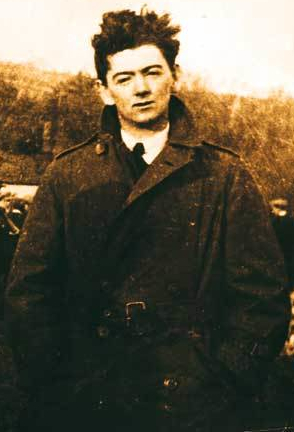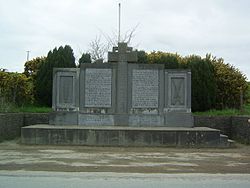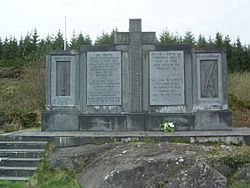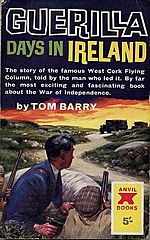Tom Barry (Irish republican) facts for kids
Quick facts for kids
Tom Barry
|
|
|---|---|

Barry c. 1922
|
|
| Chief of Staff of the IRA | |
| In office 1937–1937 |
|
| Preceded by | Seán MacBride |
| Succeeded by | Mick Fitzpatrick |
| Personal details | |
| Born | 1 July 1897 Killorglin, County Kerry, Ireland |
| Died | 2 July 1980 (aged 83) Cork, Ireland |
| Resting place | St. Finbarr's Cemetery, Cork |
| Spouse | |
| Education |
|
| Military service | |
| Allegiance | |
| Branch/service |
|
| Rank | General |
| Unit | Irish Republican Army |
| Commands | Officer Commanding, 3rd (West) Cork Brigade, Irish Republican Army Chief of Staff, Irish Republican Army Operations Officer, Irish Army's Southern Command |
| Battles/wars |
|
Thomas Bernardine Barry (born July 1, 1897 – died July 2, 1980), known as Tom Barry, was a famous guerrilla leader. He played a key role in the Irish Republican Army (IRA). This was during the Irish War of Independence and the Irish Civil War. He is best known for planning the Kilmichael Ambush. In this battle, his group defeated a large patrol of British forces.
Barry was born in County Kerry. His father was a former police officer. In 1915, when he was 17, Barry joined the British Army. He fought in the Middle East during World War I. At first, he felt loyal to Britain. However, his feelings changed towards Irish republicanism. He said this change began after he heard about the Easter Rising in 1916.
In July 1920, he joined the IRA's 3rd Cork Brigade. He used his British Army experience to train his unit. This made them a very strong fighting group. Barry became their commander. He led his Brigade in many successful attacks. These included the famous ambushes at Kilmichael and Crossbarry.
Barry was part of the Anti-Treaty IRA. These republicans did not agree with the Anglo-Irish Treaty. When the Civil War began, Barry was briefly jailed. But he escaped and led Anti-Treaty forces in southern Ireland. When it was clear they could not win, Barry suggested the Anti-Treaty IRA should stop fighting. He continued to be part of the IRA after the Civil War. He even served briefly as its commander-in-chief in 1937. Later, Barry wrote a book called Guerrilla Days in Ireland. It was about his time fighting in Ireland.
Contents
Early Life and School
Thomas Barry was born in Killorglin, County Kerry. His parents were Thomas Barry Senior and Margaret Donovan. His father was a policeman in the Royal Irish Constabulary. Four years later, his father left the police. He started a business in Rosscarbery, County Cork.
Barry first went to Ardagh Boys' National School. Later, he attended Mungret College in County Limerick. He was there from August 1911 to September 1912. He left early, as school records show he "ran away" from the college.
Serving in World War I
In 1915, during Ireland's part in World War I, Barry joined the Royal Field Artillery. He became a soldier in the British Army in Cork.
Barry joined the army on June 30, 1915. He went to Athlone for basic training. After six months, he was sent to the Mesopotamian front. This area is now Iraq. He fought there from January 1916. On March 1, he became a corporal. In April, he heard about the Easter Rising. He called it "a rude awakening." Barry asked to go back to his original rank of gunner. He stayed a gunner until the war ended.
From 1917 to 1918, he fought in other battles. His unit had many losses. In May 1918, his group moved to the Egyptian front. Barry stayed in Egypt until February 1919. Then he returned to Ireland. Barry was officially discharged from the army in April 1919. He was described as a good and hardworking man.
Fighting for Independence
When Barry came back to Bandon in County Cork, he started studying law. He also made friends with former soldiers. He began to connect with the Irish republican movement. At first, some local republicans did not trust him. This was because he seemed proud of his British Army service.
Barry applied to join the British Civil Service. But he did not pass the exams. In July 1920, he officially joined the 3rd Cork Brigade of the Irish Republican Army (IRA). The IRA was fighting in the Irish War of Independence (1919–1921).
Several things led to his decision to join the IRA. One reason was that he could not find a job after the war. Another was the death of John Bourke, a fellow former soldier. Bourke was killed in a fight between Irish veterans and British troops. Barry helped at Bourke's funeral. Also, two IRA members from Bandon were badly beaten by British officers.
Barry was interviewed by IRA officers before joining. He overcame their suspicion that he might be a spy. By late summer, he became the brigade's training officer. The IRA valued his military experience. He was able to train new volunteers very well.
The IRA was developing its guerrilla tactics. Small groups of dedicated fighters were being formed. Barry took part in training camps. He also joined attacks on British forces in 1920. These included the Fanlobus ambush and the Tooreen Ambush. He also tried to target local police and officials.
Barry soon became the commander of the West Cork Brigade's flying column. He became famous as a guerrilla leader at the Kilmichael Ambush on November 28, 1920. This was a major event in the war. A group of 18 British Auxiliaries was defeated. Three IRA men were killed. Barry always denied claims that his men killed Auxiliaries who had surrendered. He said he ordered no prisoners after the Auxiliaries faked a surrender. This fake surrender led to the death of some of his men.

After Kilmichael, Barry was in the hospital for a while. Martial law was declared in County Cork. In December, his column regrouped. They attacked police and military buildings in West Cork. In February 1921, Barry's column tried to attack the police barracks in Rosscarbery. They stayed at a Loyalist family's house to hide. But British forces were tipped off. After a short fight, Barry and his men escaped.
In March 1921, Barry gathered his largest guerrilla force. It had 104 men. At the Crossbarry Ambush, they broke out of an encirclement. A British force of 1,200 soldiers had surrounded them. At least ten British soldiers were killed. Three IRA volunteers also died, including commander Charlie Hurley.
British forces in County Cork had over 12,500 men. Barry's group had no more than 310. Barry's tactics made West Cork very difficult for the British to control. In 1921, British forces launched large searches in West Cork. They used planes and armored vehicles. Barry's column had to stay "on the run" in the mountains. They avoided being caught. They managed one more major attack on the Rosscarbery police barracks.
Barry's skill as a guerrilla commander was well known. In 1921, he was called to Dublin. He met with IRA leader Michael Collins and President Éamon de Valera. He also helped form the IRA's First Southern Division. He was made its Deputy Commander.
Barry said his unit took a firm stance against those who helped the British. He stated that his unit burned the houses of local loyalists. This was in response to British forces burning republican homes. He also said they carried out revenge killings of captured British soldiers. This was in response to the execution of IRA men.
The war in Cork ended with a truce on July 11, 1921. Barry said he felt "dazed and uncertain of the future." But he was relieved that the "days of fear were ended." He claimed his unit had killed over 100 British troops.
Role in the Civil War
During the truce, Barry married Leslie Mary Price. She was also a republican activist. Barry did not support the Anglo-Irish Treaty of December 6, 1921. He felt it gave up the idea of an Irish Republic. He also believed it accepted the division of Ireland. In March 1922, he attended an IRA meeting. They rejected the Dáil's power to approve the Treaty. He was elected to the anti-Treaty IRA's executive.
On June 28, 1922, the Irish Civil War began. Free State forces attacked the Four Courts in Dublin. Barry was in Cork, but he went to Dublin. He was captured and jailed in Mountjoy Gaol in July 1922. In September, he escaped from a camp in Gormanston. He went south to command the anti-Treaty IRA Second Southern Division.
Barry returned to being a guerrilla commander. He led a group of about 200 men in West Cork. In December 1922, he led his men to capture several towns. These included Carrick on Suir and towns in Kilkenny. They killed two Irish National Army soldiers. They also captured over 110 Free State soldiers and took their weapons. But he could not hold these towns for long. He had to leave them before more National Army soldiers arrived.
As 1923 went on, Barry's group became weaker. Many men were killed or arrested. By February 1923, Barry argued with Liam Lynch, the Republican commander. Barry believed the war should end. He felt there was no hope of winning. Barry suggested a ceasefire at an IRA meeting in March. But his idea was voted down. After Lynch died in April, the anti-treaty campaign stopped. Frank Aiken ordered them to "dump arms" in May.
Barry had to stay hidden until November 1924. That is when a general amnesty was declared. The Third Cork IRA Brigade, which Barry led, lost 34 men in the war against the British. Another 21 anti-Treaty fighters died in the Civil War.
Later Life and Writings
Tom Barry left the IRA leadership in 1923. However, he remained involved as a member. He later took on a leadership role again in 1932.
From 1927 to 1965, he worked as a general superintendent for the Cork Harbour Commission. In 1937, he became the chief of staff of the IRA. Barry planned an IRA attack in Northern Ireland. But the plan was canceled due to leaks. Barry later said he was against the IRA's bombing campaign in England. He also said he opposed IRA contacts with Nazi Germany. However, he had visited Germany in 1937 to seek German support.
In 1940, Barry was put in charge of intelligence for the Irish Army's Southern Command. He held this position during World War II (called The Emergency in Ireland). In 1941, the IRA criticized him for writing for An Cosantóir, the Irish Army's magazine.
In 1966, Barry was invited to events for the 50th anniversary of the Easter Rising. He declined because he was serving in the Middle East at the time of the rising. On July 10, 1966, Barry attended the unveiling of the Kilmichael ambush monument. He and other survivors formed a guard of honour.
Barry had strong opinions on the Northern Ireland conflict after 1969. He argued in 1971 that peaceful ways would not achieve Irish unity. He supported armed action there. However, he was against IRA bombings that killed civilians. By 1977, he seemed disappointed with the IRA campaign. He said the people doing the recent killings "could not be called IRA." He refused to support Provisional IRA hunger strikers in 1977. He was against the Provisional IRA's tactics, especially car bombs against civilians. But he defended attacks on British soldiers on duty in Northern Ireland.
His Memoir: Guerrilla Days in Ireland
In 1949, Barry published his book about the Irish War of Independence. It was called Guerilla Days in Ireland. The book describes his Brigade's actions. These include the ambushes at Kilmichael and Crossbarry. It also tells about other less known actions. These were against the British Army, Black and Tans, the Auxiliary Division, and the Royal Irish Constabulary.
Death
Tom Barry died on July 2, 1980, in a hospital in Cork. He is buried in St. Finbarr's Cemetery, Cork.
See also
- Dan Breen
- Seán Hogan
- Seán Mac Eoin



